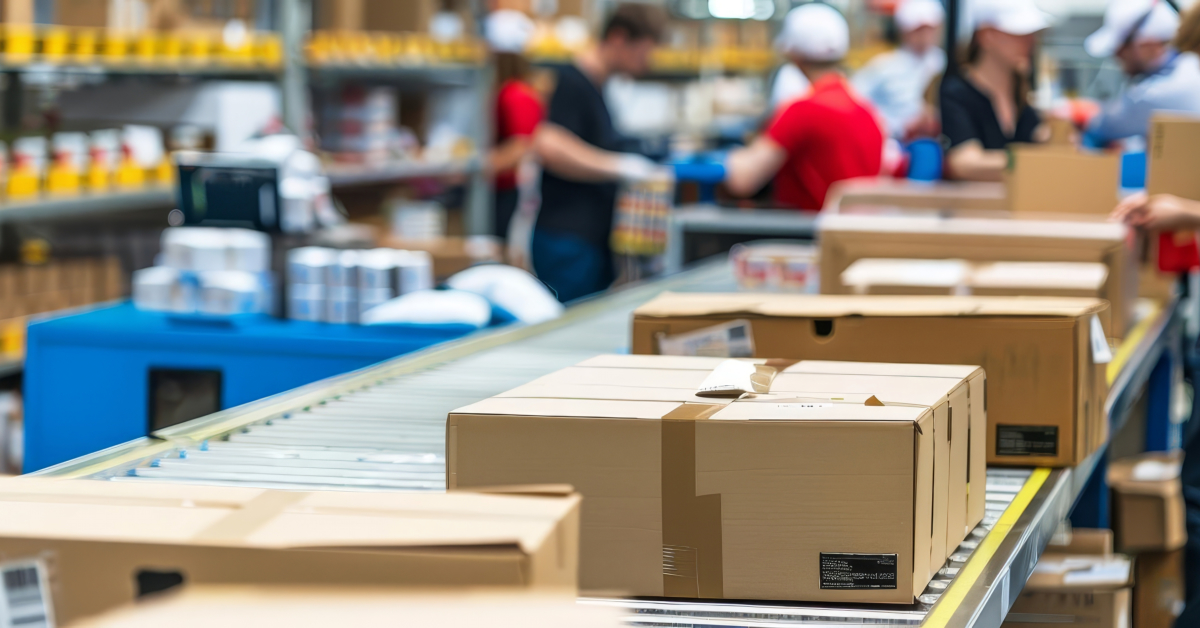Fulfillment operations are the backbone of any business delivering products to customers.
However, they come with inherent risks—from inventory mismanagement to operational delays, human errors, and cybersecurity threats. Whether it’s shipping directly to customers, restocking retail stores, or managing distribution, one thing is clear — customers expect fast and error-free deliveries. But meeting these expectations isn’t always easy.
Businesses must adopt innovative technologies and implement effective strategies to maintain smooth and efficient operations. This article explores cutting-edge technologies and practical strategies that can help lower risks in fulfillment operations while ensuring a streamlined and efficient process.
Key Takeaways
- Leverage AI, IoT, and automation to streamline operations and minimize errors.
- Safeguard your fulfillment processes with robust tools like encryption and 2FA.
- Equip your team with skills and implement quality control to prevent costly mistakes.
- Use predictive analytics and contingency plans to ensure uninterrupted operations.
What Are the Main Risks in Fulfillment Operations?
Fulfillment operations face several challenges that can disrupt efficiency and impact customer satisfaction. One key issue is inventory management—having too much stock ties up money and space, while too little results in missed sales and unsatisfied customers.
Errors in packing or labeling orders lead to incorrect deliveries or returns. It also increases costs and negatively affects customers. At the same time, cybersecurity threats, such as data breaches, pose significant risks to both operational systems and customer trust, with potential for severe financial and reputational damage.
Technologies To Lower Risks in Fulfillment Operations
Choose the right technology for your business to maintain trust and loyalty with customers and more resilient fulfillment operations.
1. Warehouse Management Systems (WMS)
A WMS streamlines operations by tracking inventory, optimizing storage, and guiding staff in picking and packing processes. It offers real-time inventory visibility, reduces human errors through automation, and integrates with supply chain tools for better forecasting. These features enhance productivity and customer satisfaction while minimizing operational costs.
2. Sensors for Inventory Tracking
Sensors have become integral across industries, such as healthcare, automotive, manufacturing, and fulfillment operations. In healthcare, advanced monitoring systems, such as those offered by frequencyprecision.com, enhance patient safety and help proactively identify potential issues. Similarly, the automotive industry relies on sensors for innovations like driverless vehicles.
In fulfillment operations, Internet of Things (IoT) sensors provide real-time updates on stock levels, storage conditions, and equipment performance, streamlining inventory management. It prevents inventory shrinkage by detecting discrepancies early and ensuring product quality by monitoring temperature and humidity for sensitive items.
3. Automated Picking and Packing Systems
Automated picking and packing systems use robotics, conveyor systems, and machine learning to streamline warehouse tasks like picking, sorting, and packing. It reduces human errors, speed up processing times, and ensure faster, more accurate order fulfillment. Automation also reduces risks of injury and fatigue while enhancing safety and efficiency.
4. Artificial Intelligence and Machine Learning
AI and ML transform supply chain and e-commerce operations by predicting demand, optimizing delivery routes, and identifying workflow inefficiencies. Businesses avoid stockouts, reduce costs, and streamline processes. With accurate delivery estimates and personalized recommendations, you can easily meet customer demands.
5. Blockchain Technology
Blockchain technology improves supply chain management by creating a transparent, unchangeable record of transactions and product movements. It enhances traceability, prevents counterfeit goods, and ensures accountability, particularly in sensitive industries like pharmaceuticals and luxury goods.
Furthermore, blockchain facilitates regulatory compliance with accessible audit trails. It fosters trust among stakeholders, and streamlines operations through smart contracts, improving efficiency across the supply chain.
6. Cybersecurity Tools
Firewalls, two-factor authentication (2FA), and data encryption are crucial for safeguarding business operations and sensitive information. These cybersecurity tools prevent unauthorized access, ensure compliance with privacy laws like GDPR and CCPA, and protect against operational disruptions caused by cyberattacks. In this way, you can maintain business continuity, foster customer trust, and build a secure, resilient digital environment.
7. Autonomous Vehicles and Drones
Autonomous vehicles and drones enhance last-mile delivery, reducing dependency on human drivers, and reaching challenging or remote locations. With the integration of AI and GPS, you can operate efficiently for faster and more reliable deliveries. With continuous operation and environmentally friendly electric power, autonomous systems improve scalability and sustainability.
8. Robotic Process Automation (RPA)
RPA automates repetitive tasks in fulfillment operations, such as order processing, invoice management, and inventory updates. This technology reduces human error, speeds up workflows, and ensures consistent, reliable performance. By integrating RPA into existing systems, businesses can handle high volumes of orders more efficiently.
9. Digital Twins Technology
Create virtual replicas of physical warehouses, equipment, and processes using digital twin technology. Businesses can use it to simulate and optimize workflows, predict potential bottlenecks, and implement preventive measures. It enhances decision-making and improves overall efficiency.
10. Predictive Analytics Tools
Analyze historical and real-time data using these tools to forecast demand trends, identify potential risks, and optimize inventory management. These tools help businesses maintain optimal stock levels, prepare for seasonal fluctuations, and prevent delays in the order fulfillment process.
Leveraging advanced technologies is essential for lowering risks and building resilience in fulfillment operations. By adopting tools like warehouse management systems, AI-driven solutions, IoT sensors, and blockchain technology, businesses can enhance efficiency, accuracy, and transparency across the supply chain.

Strategies To Lower Risks in Fulfillment Operations
Below are effective strategies to protect your bottom line, and deliver consistent, high-quality service to your customers.
1. Invest in Employee Training
Employee training enhances efficiency by equipping teams with vital skills. Focus on new technologies like robotics, best practices in handling, packing, and shipping, and cybersecurity threat recognition. Well-trained employees adapt to change, prevent costly mistakes, and drive innovation, ensuring long-term business success.
2. Implement Quality Control Processes
Quality control ensures error-free operations and customer satisfaction. Key strategies include regular inventory audits to identify issues, using checklists to verify order accuracy before shipping, and employing technology for automated quality checks. These practices boost efficiency, reduce errors, and protect your business reputation.
3. Enhance Supplier Relationships
Strong supplier relationships minimize risks like stockouts and delays while fostering reliability. Key practices include establishing clear communication channels for alignment, collaborating on inventory forecasts to improve planning, and maintaining backup suppliers to ensure continuity. These strategies build a resilient supply chain, enhance efficiency, and support long-term business growth.
4. Optimize Supply Chain Planning
Optimize your supply chain by leveraging predictive analytics to maintain safety stock for high-demand items, ensuring readiness for demand fluctuations while avoiding overstocking. Diversify transportation modes to mitigate delays and enhance resilience, while real-time insights improve coordination and transparency across the supply chain. These strategies reduce costs, prevent shortages, and create a more efficient, adaptable system
5. Monitor Key Performance Indicators (KPIs)
Monitoring KPIs like order accuracy, inventory turnover, and on-time delivery rates provides actionable insights to identify workflow weaknesses, quickly address issues, and prevent disruptions. Regular analysis allows businesses to benchmark performance against industry standards, optimize operations, and stay competitive by leveraging data-driven strategies for continuous improvement and customer satisfaction.
6. Adopt a Proactive Maintenance Approach
Adopting a proactive maintenance approach prevents equipment failures and minimizes downtime. Key strategies include scheduling regular inspections for early issue detection, utilizing IoT sensors for real-time performance monitoring and predictive alerts, and maintaining an inventory of spare parts for quick repairs. These practices ensure seamless operations, reduce costs, and enhance reliability.
7. Develop a Contingency Plan
A robust contingency plan ensures business continuity during disruptions by addressing alternate transportation routes, emergency staffing, and cyberattack recovery solutions. Key strategies include mapping backup logistics, cross-training staff, maintaining on-call resources, and preparing cybersecurity response plans. Proactive planning minimizes risks, ensures operational resilience, and supports long-term business success.
8. Conduct Regular Risk Assessments
Regular risk assessments identify vulnerabilities and ensure preparedness by mapping the fulfillment process, involving cross-functional teams for diverse insights, and documenting findings with prioritized actions. This proactive approach minimizes disruptions, enhances operational stability, and fosters long-term growth by addressing risks systematically and adapting to changing business environments.
9. Leverage Third-Party Logistics (3PL) Services
Partnering with third-party logistics providers can reduce fulfillment risks by outsourcing complex tasks like warehousing, order processing, and shipping to experienced professionals. 3PL providers often have advanced technology, robust networks, and established contingency plans to handle disruptions. This approach ensures scalability, operational efficiency, and a higher degree of reliability in meeting customer expectations.
10. Integrate Supply Chain Visibility Tools
Implementing supply chain visibility tools allows businesses to track shipments, monitor real-time inventory levels, and identify potential bottlenecks across the supply chain. These tools improve coordination among stakeholders, provide actionable insights for risk mitigation, and enhance transparency. Greater visibility ensures better decision-making, minimizes delays, and strengthens overall supply chain management.
From leveraging advanced technologies and quality control processes to fostering strong supplier relationships and contingency planning, each approach contributes to a resilient, efficient, and customer-centric fulfillment system.
Frequently Asked Questions (FAQ)
1. What role does AI play in fulfillment operations?
AI predicts demand, optimizes delivery routes, identifies workflow inefficiencies, and enhances customer experience through personalized recommendations and accurate delivery estimates. It also helps in fraud prevention and improving overall operational efficiency.
2. How can businesses protect fulfillment operations from cybersecurity threats?
Implementing robust cybersecurity tools such as firewalls, data encryption, and regular system updates can prevent unauthorized access, ensure data security, and maintain business continuity.
3. Why is proactive maintenance important in fulfillment operations?
Proactive maintenance minimizes equipment downtime by detecting issues early, scheduling regular inspections, and utilizing IoT sensors for real-time monitoring. It ensures seamless operations, reduces repair costs, and improves system reliability.
4. How can companies improve supplier relationships to lower fulfillment risks?
Strong supplier relationships can be built by maintaining clear communication, collaborating on inventory forecasts, and having backup suppliers. These practices ensure reliable stock availability, reduce delays, and enhance supply chain resilience.
Conclusion
A holistic and proactive approach can help lower the risks of fulfillment operations. In this way, you can achieve safer, more efficient, and scalable fulfillment operations to drive long-term success. Talk to an e-commerce tech expert and strategist today!




